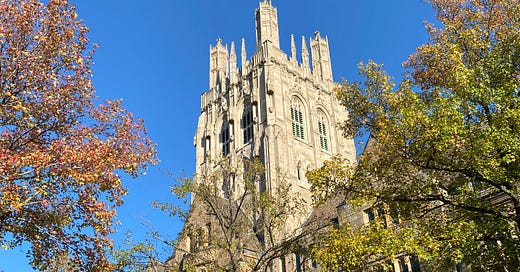Can Colleges Be For Everyone?
Jonah was born, ratherly inconveniently, when Steve and I were still working on our dissertations. We didn’t start saving for Jonah’s college education at that time as the baby books recommended, in part because we were as poor as dirt. Our spare nickels and dimes were not going to make a dent in $70,000 of college expenses.
We also didn’t save for college for the kids twenty years ago, because we felt that there was a 50/50 chance that higher education was not going to exist much longer. After more than a decade in the trenches of academia, as students, researchers, and as professors, we knew that the system was on a shaky foundation. But colleges still exist, so the laugh was on us when we had to quickly assemble a large pile of cash to send Jonah to college.
Most high school graduates — 66 percent in 2019 — go straight to a two-year or four-year college. While many start college, finishing college proves to be difficult for many; nearly 40 percent of those college attenders do not graduate even after six years at a school. Overall, only a minority of Americans, 25 years or older — 32 percent — have a four-year college degree.
The numbers don’t lie. Getting a bachelor’s degree in a timely manner continues to be a struggle for most young people. And with a declining investment in education and recent shocks to society, we are not going to see swelling numbers in lecture halls, at pledge night at Phi Gamma Delta’s frat house, or even on the local bus to community college. But that doesn’t mean that Steve and I were right twenty years ago. The truth is that higher education is morphing and changing; college might not resemble our experiences of liberal arts majors, grassy campuses, and kegs in dorm rooms, but it’s not going anywhere.
The options for disabled adults are exploding. I’ve written several newsletter posts chronicling my experiences trying to find a place for my son with high functioning autism. (We visited another promising program in Connecticut yesterday.)
As part of my research for my son, I discovered a host of brand new programs for disabled students in the Northeast. Students with intellectual disabilities can now live in supported dorms on campuses and learn jobs skills in college dining halls and libraries. There are programs with students, like Ian who have higher functioning autism, and need support with organizing their work and making friends, but can handle the classes. Some of these programs rely on huge tuition payments from parents, but others are flush with new cash from the state and feds and are practically free for parents.
Those who can manage four-year colleges are finding new practical options. Because students fear racking up lots of debt for majors that aren’t clearly tied to a post-graduation job, humanities majors are going the way of the dinosaur. According to the Hechinger Report, in recent years, “more and more students turned away from the humanities and opted to major in engineering, health and other career-oriented fields.” And colleges are responding. Jonah’s girlfriend is a HR major. Unlike Jonah the political science major, she knows exactly what she’ll be doing the week after graduation.
While community colleges are struggling and weren’t nimble enough to deal with the pressure from the pandemic — enrollment in two-year colleges is down 10 percent nation-wide — new career and technical programs are opening up. Highly problematic for-profit colleges have dominated this sphere for many years. Community colleges, with their on-going identify crisis and history of bad decisions, haven’t been able to meet the need for high school graduates to get the skills to fix cars, repair laptops, code medical paperwork, and organize the social media for small businesses. So, publicly funded career and technical high schools and specialized programs within four-year colleges are opening up. At one local college, you can get learn about the craft brew industry or medical coding without having to waste time taking classes you hate.
College isn’t for everyone, you hear people say. While traditional college may not be everyone, perhaps these new models of higher education can be for everyone. They can provide an education in trade or life skills to help bridge high school with the demands of the real world.
The next step is for high schools to understand this complex new world and to education students and families about all the new options. High school counselors need to catch up quickly. As I wrote last year, counselors are few in number; some states have 1 for every 600 students. They are trained to help kids with their social-emotional needs, not college and career planning. There are no incentives for them to provide information to kids about alternatives for four year programs, because their schools rankings are based on graduates’ attendance at 4-year colleges. But this “college or bust” model is out-dated and not serving students.
I am actually very excited about all the opportunities for young people. While I may have loved everything about traditional college — dorms, Plato, late night debates with roommates, senior projects, art classes, advance political theory — I also know that I’m an outlier. Most people don’t want or need all that. As the higher education market FINALLY responds to new demands, I hope that we can steer students in the right directions without jargon, without politics, and without a huge price tag.
LINKS
Yesterday, I made Christmas garland using the vintage thread from an aunt that passed away. Story here.
Here’s my technology gift guide.
Steve’s London and Toronto offices closed this week, and they sent home the trading floor from NYC. He won’t be going back to the office for a while. Pleeassseee, COVID Gods, do not close the schools.
We are hopefully going skiing in Vermont the first weekend in January. So far, we booked a hotel that we can cancel and didn’t buy lift tickets, because we’re worried that things will shutdown again. But even if COVID goes away, I am not skiing downhill. I’m too old for that. But I might do Cross Country skiing at the Trapp Lodge.
You know things have really gone to shit when Don Trump, Jr. is the smartest guy in the room.
Spielberg’s West Side Story was not as good as the original. The music and dancing did not have the original’s POW and SNAP. And this new version lacked humor and subtle snark of the original.
We’re taking Ian to see the Nutcracker Suite this Saturday. Fingers crossed, it does get cancelled.
More information might not help students make better higher ed choices. But better transportation might help them out a lot.
bell hooks passed away.
Climate Change’s Effects on 193 Countries.
Cooking: Another sheet pan chicken thighs recipe.





